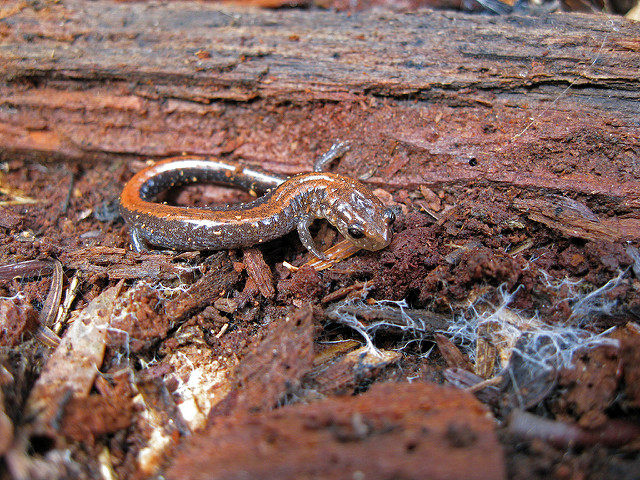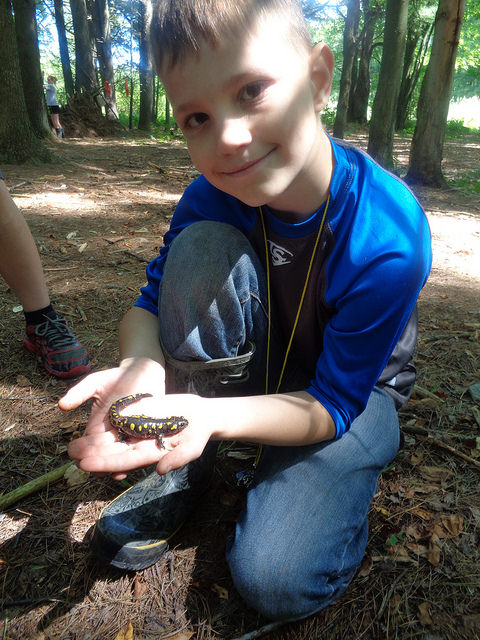Imagine a small, slimy creature. They are ubiquitous in the good forests, the ones with leaf litter, plenty of debris, and good soil quality. Not too wet, but dampness is essential. They are carnivores, eating myriad tiny invertebrates but known to eat the eggs and young of its own kind. Carnivorous and opportunistically cannibalistic. They are likely unknown to most folks in the area despite being the most abundant vertebrate. I have held hundreds and never cease to wonder at them.
Plethodon. The name even sounds prehistoric. But flip the perfect rock, log, or debris and you may just spot one. Their eyes bulge out the sides of their heads, and they appraise you coolly, with the hint of a smile. A brick red stripe on their backs denote the rest of their name, cinereus. What you see is the Red-backed Salamander.

Red-backed Salamander. Photo by Jennifer Schlick.
They are not much more than two inches in length, not including the tail. Why not include the tail? Well, because sometimes they don’t have one. Fighting with other red-backs, escaping from danger, or being handled too roughly by a well-meaning child are all causes for tail loss. No worries that there are no remedies for such an ailment, the tail will regrow in time. Their diminutive size gives them a fairy-esque quality and those that meet them always seem to be enchanted.
Despite their name, sometimes these salamanders lack the red coloring, earning the name “leadback” and recognized as a separate phase, which happens to be fairly common in our area. In both they have a salt and pepper belly. I don’t know if you’ve ever tried to look at the belly of a slippery, sticky, slimy, tiny animal, but I recommend and clear jar or bag. Much easier. They also sport gold flecking along their sides and back. There is little to ponder as to their presence in jewelry motifs, they are quite attractive.
I have found these little sallies frequently at home, under shingles (put out for the snakes – yes, I do it on purpose), boards, rain barrels, piles of compost in the garden, and most often under the woodpile. In stacking wood for the season, the end result is comical for a day. Scattered random pieces left on the ground with no rhyme or reason, so it seems. They are all at least three feet away from each other. Under each is a red-backed. Eventually they will move to another cover, but I will leave those pieces of wood there until they choose to do so.

Holding a Spotted Salamander at Day Camp.
You see, Red-backed Salamanders have small territories, often just a square meter, that they defend fiercely. Pretty plucky for such a small creature. They will defend more often against strangers than neighbors regardless of gender. Did you know salamanders have teeth? Yes, they do, sharp ones. They use them to bite off each other’s tails or to scratch another’s “nose.”
It isn’t a nose in the sense that you and I have a nose. Plethodon species breathe through their skin, and so their noses are not respiratory adaptations. Rather, they have two grooves leading to their “noses” which pick up chemical cues from other salamanders. Basically, it is how they talk. In battle, damage to these nasolabial grooves can severely impact an individual. Without being able to communicate with others, the salamander cannot detect territories of the presence of males or females during breeding season. Their typically long lives may be cut short as they wander. So, long-lived, yes. These little guys, remember not much more than two inches, usually live about a decade. That’s impressive!
Okay, a lot of information, let’s get back to the thrill of finding them. There are many more salamanders in New York and Pennsylvania than just this one. Their array of patterns is fascinating and mesmerizing. Yellow spots, white dots, blue speckles; ebony black racing stripes on a gold body, chevron patterns, and colors ranging from brown to pink to yellow. The smallest is about two inches, the largest pushes 24 inches. A two-foot salamander! Right here in the Allegheny Plateau! Habitats are just as varied, from wooded hillsides to trickling streams, boggy ponds to rocky-bottomed rivers.
These are nocturnal creatures, you aren’t going to see them unless you go look for them. And like so many other wonders of nature that we don’t interact with, these are worth the hunt. Flip over anything in the woods, carefully so as not to squish anyone, and always put things back how you found them. You just took the roof off their house, essentially. If the salamander has moved, scoot him a little farther so you can put the log or rock back safely. The same can be done in shallow creeks and cool springs.
Bring a camera. Often their first reaction is to freeze in place so you can get a good shot of them. Have it on the macro setting, because they are small. You can pick them up but be aware of a few things. Being amphibians they are extremely sensitive to chemicals – including insect repellent, sunscreen, and hand lotion. Some states regard certain species as protected or as a harvestable species you need a fishing license to “hold.” Check the regulations before you go.
Most importantly, be enchanted. Imagine their lives. Look into their eyes and return the grin. We impact them daily with our actions from logging to acid rain, so it is nice to get to know the individuals in your neighborhood on their terms. Since they live quite a long time, you may be able to greet the same individual regularly. Happy salamandering!
Audubon Community Nature Center builds and nurtures connections between people and nature. ACNC is located just east of Route 62 between Warren and Jamestown. The trails are open from dawn to dusk as is Liberty, the Bald Eagle. The Nature Center is open from 10 a.m. until 4:30 p.m. daily except Sunday when it opens at 1 p.m. More information can be found online at auduboncnc.org or by calling (716) 569-2345.
Sarah Hatfield is a naturalist at ACNC.


Recent Comments